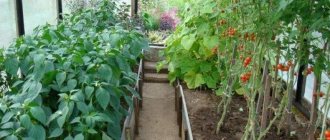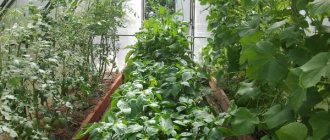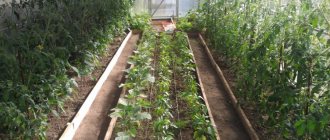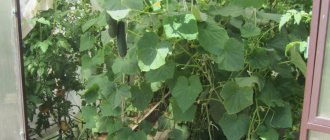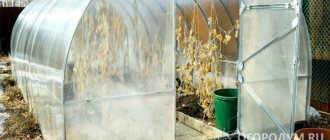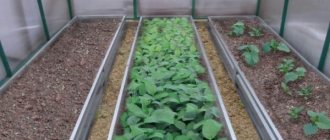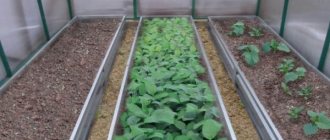Mixed or compacted plantings are beneficial to us from several angles. Firstly, we get more harvest from one bed. Secondly, the earth is never empty, which means it does not crack, does not erode, and loses less moisture and nutrients. Thirdly, correctly selected accompanying crops will also help us in pest control.
In addition to the main crop, it is recommended to sow several accompanying crops, even in a greenhouse in the same bed with our beloved tomatoes. Let's find out what can be planted next to tomatoes in a greenhouse, which neighbors will be happy with them, and which ones - not so much.
What can you plant with cucumbers in a greenhouse? What can be planted with cucumbers in a greenhouse and 4 risk factors
Growing cucumbers is not as easy as it might seem at first glance. After all, it is necessary to maintain ideal conditions in which there should be a stable temperature and high humidity. Germination of this crop in open ground is impossible and therefore a greenhouse or greenhouse is required. As a rule, greenhouses are large in size, and gardeners combine several types of plants. However, is this correct, and what crops can be planted in the same greenhouse along with cucumbers?
How can you plant cucumbers in a greenhouse?
Mostly, beginning gardeners have one greenhouse installed, in which they strive to plant as many crops as possible. The main argument in favor of such an activity is the saving of space and the minimum cost of maintaining the structure. It is worth noting that it is not always possible to plant many crops in one greenhouse, as this can cause them: death, low yield, cross-pollination, which will lead to the formation of hybrids with far from the best characteristics.
Risk factors include:
- Different temperature requirements;
- Different humidity levels;
- Use of different fertilizers;
- Spread of pests from one crop to another.
In other words, if vegetable crops are placed incorrectly, both work and time can be wasted, since the harvest will be small and may be defective. In addition, the development process of each plant will begin to slow down and a massive shedding of ovaries is quite possible. In one greenhouse you can place only those vegetable crops that are related to the same family or have similar maintenance requirements.
For example, cucumbers require high humidity and warmth, as well as long daylight hours.
It is worth choosing neighbors for them based on precisely these criteria. When choosing certain crops, you need to pay attention not only to the species themselves, but also to their varieties. For example, very often cucumber hybrids are planted next to eggplants. Both types of plants are resistant to temperature changes and changes in air humidity.
Recommendations: what can be planted in a greenhouse along with cucumbers
There are a number of vegetable crops that can be planted next to cucumbers in the same greenhouse.
These include:
- Sweet peppers require a humidity of at least 80%, warm air and good lighting. It is strictly forbidden to plant sweet peppers next to hot ones, as they are cross-pollinated and the sweet fruits begin to taste bitter.
- Eggplants are considered excellent neighbors, since for excellent development they require heat of at least 28 o C, as well as increased soil moisture.
- White cabbage is considered to be very moisture-loving, but it needs a lot of light. The early variety can be planted in mid-April, and after the fruits have been collected, re-planting of the late-ripening variety is permissible.
- Radish is an early crop, and it is not demanding of heat, but prefers moisture. If you plant it along a bed of cucumbers, it will not only make the harvesting process easier, but will also contribute to the excellent development of cucumbers.
- Zucchini, no less than cucumbers, require warmth and high humidity, but they need a constant flow of air, and if they are grown in a greenhouse, they need regular ventilation. It is best to plant zucchini next to crops that are hybrid and have excellent resistance to temperature changes.
Worst options
A poor choice can negatively impact the yield of both crops. Therefore, the company's choice of tomatoes should not include dill, cucumbers, fennel, zucchini and pumpkin. Such plants can absorb beneficial substances needed by another vegetable, which will have a detrimental effect on their condition. In addition, caring for plants differs significantly. It is simply not possible to create the necessary conditions in one greenhouse for both crops.
Growing vegetables is a painstaking task that requires a responsible approach and the study of relevant information. Many gardeners believe that experience comes with age. However, it takes a lot of time to gain knowledge in this way. A more modern method has been to study the necessary information on the Internet.
What can you plant in a greenhouse with tomatoes? The best neighbors for tomatoes in a greenhouse
When selecting the right neighboring crops for tomatoes that are grown indoors, take into account the characteristics of the microclimate, planting plants with similar requirements for temperature, lighting, etc. It is also necessary to pay attention to the size of the structure and structural features.
1-2 months before planting tomato sprouts, it is recommended to sow the soil in the greenhouse with early and fast-growing crops, such as: onions and garlic (for green feathers), various varieties of lettuces, radishes and kale. When the time comes for tomato seedlings, it is enough to make room among the already grown neighbors. While the tomatoes are growing and developing, the previously planted crops are harvested.
Various types of herbs, legumes, melons and greens, some varieties of strawberries and cabbage feel good in greenhouse conditions. But it is important to remember that small plants must also get sunlight to grow well, so tall and spreading tomato bushes need to be tied up in a timely manner.
Peppers are often chosen as neighbors for tomatoes. This is a good option since they have similar temperature and humidification requirements. Both crops need a garter and 1 trellis is enough for both of them. In addition, the specific aroma of tomato tops drives away aphids, the main enemy of pepper. However, it must be taken into account that peppers and tomatoes are crops of the nightshade family, which implies the same diseases, so such a combination is allowed with reliable protection against infections.
Cucumbers are no less popular than tomatoes, so they are also often planted nearby. However, this is not the best neighborhood, since crops have different microclimate requirements - cucumbers need higher humidity and temperature, as well as a complete absence of drafts.
Another popular crop for growing in greenhouses is eggplant. But this is also not the best neighbor for tomatoes, because in addition to the fact that they have different requirements for microclimatic conditions, they are also prone to the same diseases. Therefore, it is recommended to prepare separate rooms for these plants. If you still have to grow eggplants and tomatoes under one roof at the same time, it is better to place the tomatoes closer to the entrance, and the eggplants just behind them.
Harvesting
The first harvest will be harvested from basil; you can start cutting it when it reaches 10 cm in height. It is most convenient to do this above the second pair of true leaves, leaving approximately 7 cm of stem height. Then, about every two weeks, you can cut a new crop.
Cucumbers begin to be collected as they ripen, first every 4 days, then daily (during the period of mass collection).
When growing basil, it is very important to study information about what you can plant basil next to, for example, whether it can be grown next to tomatoes.
Features of growing for sale
To grow basil for sale, a heated greenhouse structure is required, since the spice is in greatest demand in late autumn, winter and early spring, and therefore prices for this product are higher.
To heat the greenhouse, you can use wood-burning stoves, as well as electric convectors or infrared heaters.
For sale, it is necessary to grow no more than 3-4 proven high-yielding varieties with a beautiful appearance and attractive aroma.
Since this spice is poorly represented on the Russian market, experts advise growing basil in seedlings on shelves, planting it in small beautiful pots, and selling it in the same form. The product will have an exclusive look, and the buyer will be able to use fresh foliage longer.
The best varieties
There are a large number of types and varieties of basil. But for a greenhouse, since its area is small, and other plants will grow along with the spice, it is better to choose 2-3 high-yielding varieties with different tastes for planting.
| Variety | Ripeness group Growing season (days) | Leaf color | Application | Productivity (kg per 1 sq. m) |
| Anise aroma | Mid-early 35-40 | Silver green | Flavoring sauces, canning vegetables | 4 |
| Yerevan | Early ripening 25-30 | Dark purple | For salads and meat dishes | 2,5 |
| Moulin rouge | Mid-season 45-50 | Dark red | For decoration, due to its mild taste in salads and canning | 3 |
| Thai Queen | Late 100-110 | Rich green | For decoration, due to the classic aroma in any dishes | 3 |
Purple and green basil differ only in the color of the leaves and the sharpness of the aroma, so they grow equally well in a greenhouse.
Preparing a room made of glass or polycarbonate
Greenhouses covered with glass or polycarbonate are suitable for growing basil. These materials transmit light well and retain heat, which is so necessary for basil.
- Preparation of the greenhouse should begin in the fall. To do this, all debris remaining after harvesting and weeds are removed, and all structural elements are disinfected with a saturated solution of potassium permanganate.
- In the spring, glass or polycarbonate coatings are thoroughly washed with soapy water.
The combination of basil and tomatoes
Basil is the best companion for tomatoes. Its proximity repels hornworms and has a positive effect on the taste of the crop. Therefore, it is worth planting basil in a greenhouse with tomatoes. It also tolerates proximity to tomatoes well. He only needs enough light and nutrition.
Tomatoes and basil
Mixed plantings with other herbs (thyme, sage, mint) are no less beneficial for tomatoes; they create protection for the garden bed from earthen pests.
Many gardeners do not know what else can be planted in a greenhouse with tomatoes. For example, to improve the quality of tomato juice and increase the shelf life of the crop, you can plant borage nearby. Among herbs, vegetables do not tolerate only proximity to lemon balm.
Step-by-step instructions for growing
Basil can be grown in an unheated greenhouse in two ways:
- sowing seeds;
- planting seedlings.
Inventory
To grow basil you will need:
- flat cutter;
- rake;
- containers with a depth of at least 7 cm;
- peg for picking;
- scissors;
- spray;
- watering cans of different volumes with different nozzles;
- a barrel with warm (not lower than 25°C) and settled water.
Seeds
Basil seeds are coated on top with a layer of essential oils, which protect them from premature germination. In order to dissolve this layer, before sowing, the seeds must be soaked in any growth stimulant for 8 hours.
You can speed up this process. The seeds are placed in a fabric bag and immersed in hot water at a temperature of 50-60°C for 2 minutes. Then the excess water is squeezed out, the bag of seeds is wrapped in polyethylene and placed in a warm place with a temperature of 25-30°C for 30 minutes.
Advice
Readiness for planting will be indicated by a slippery layer on the surface of the seeds - these are dissolved essential oils.
The soil
For growing basil, sandy loam soil with neutral acidity, well fertilized with organic fertilizers, is preferable.
The soil in the greenhouse is prepared in the fall. To do this, dig it up to a depth of 25-30 cm (on the bayonet of a shovel) and add it to every 1 square meter. m:
- 4 kg of humus;
- 25g superphosphate;
- 15 g of any fertilizer based on potassium salt.
In spring, the soil is loosened with a flat cutter and treated with copper sulfate. A small amount of complex fertilizers can be added to the soil.
Planting scheme and technology
- When planting basil seeds in the soil of a greenhouse, grooves are made in it at a distance of 30-35 cm from each other and 1-1.5 cm deep. The grooves are shed with warm water from a watering can. The prepared seeds are placed in them, at intervals of at least 10 cm, and covered with a thin layer of soil, slightly compacting it. The planted seeds are covered on top with plastic film.
- When using the seedling method, seeds are planted in pre-disinfected containers to a depth of 1 cm, with a distance of 3 cm between them. The containers are also covered with plastic film. After the first shoots appear (after 10-15 days), the film is removed. As soon as the first 2 true leaves appear on the seedlings, the seedlings are picked. In this case, the central root is cut to 1/2 of its length, and the best seedlings are transplanted into containers, in the soil of which holes are made 6 cm deep and about 3 cm in diameter. The distance between the holes should be at least 6 cm.
The seedlings are transplanted into the greenhouse soil after 35-45 days, when the seedlings have 4-6 true leaves according to the following scheme:
- between seedlings - 15-25 cm (depending on the variety);
- between beds - 35 cm.
Care
Before emergence
Before the first shoots appear, the soil, as it dries, is constantly moistened with warm, settled water from a watering can with a wide spray nozzle.
After the appearance
After the first shoots appear, it is very important to maintain the temperature in the greenhouse at least 25°C. Watering is reduced to once a week, and after each irrigation, weeds must be removed and the soil loosened.
Basil is fertilized twice:
- The first time - 14 days after germination with a complex fertilizer containing potassium, phosphorus and nitrogen (10 g per 1 l).
- The second time - with the same solution 14 days after the first feeding.
Advice
After the appearance of the 6th leaf, the basil is pinched, allowing side shoots to develop.
Harvesting
The first harvest is harvested when the basil bush reaches a height of 20 cm. The branches are cut with pruners above the 2nd pair of true leaves - this is 7 cm above the soil level. New shoots with tender and succulent leaves grow from the axils on the 15-20th day, and they are cut off again.
Thus, several harvests can be collected before the general flowering begins. The last harvest is usually cut to dry the leaves, as the shoots become tougher, and to harvest seeds.
After each cutting, the soil around the basil is loosened and complex fertilizers are added to it.
Principles of mutual influence
Even if you don’t set yourself the goal of saving space on your site, it makes sense to pay attention to complementary and mutually exclusive features when planting garden crops together. This will help save energy and time, reduce the amount of work and make it easier to care for the plantings. After all, with proper compaction, a much smaller area has to be processed. Plants may be completely neutral towards nearby green companions, but they are still dependent on subtle, invisible connections.
Experienced farmers actively apply the principles of mutual influence in mixed plantings, having tested their effectiveness in practice.
When planning complementary options for joint planting for the future, you need to build on the needs of the main crop, in this case tomatoes
The pivotal root system of tomato bushes, with many strong branches, goes to more than a meter deep, which allows them to obtain moisture on their own. Therefore, during the flowering period, moderate watering will be enough for the plants, and when it is time to set and ripen the fruits, it is practically not needed. Conditions conducive to the proper development of tomatoes and high yields are also relatively dry air, good natural ventilation or regular ventilation (in greenhouses) and sufficient lighting.
Crop rotation rules
One of the first rules that allows you to always get a rich harvest with a minimum of effort is compliance with crop rotation. It is based on the fact that each plant extracts a unique combination of microelements from the earth. Some need more nitrogen, iron and manganese, while others need more potassium, magnesium and zinc.
Of course, if you plant the same plant on your plot every year, the supply of substances needed to grow it will rapidly deplete. It is not surprising that in two to three years the yield will drop sharply. As experts say in such cases, “monoculture kills the soil.”
To prevent this from happening, you need to change the location of the beds every year. Moreover, it is important to ensure that not only one plant, but also those close to it are not grown in one place. For basil, these are all herbs, such as savory, marjoram, coriander and tarragon - they take approximately the same substances from the ground.
Fact! Growing closely related crops in one area not only depletes the land, but also increases the risk of dangerous infectious diseases.
Experts recommend not returning the crop to its old place for at least three years - only in the fourth year can it be re-grown in its old place. Thanks to this planting, you can grow a really rich harvest.
Culture compatibility table
| Good neighbors for tomatoes | Neutral | Bad |
| Marigolds, nasturtium, marigolds | Eggplant | Potato |
| Radish | Carrots, beets | Cucumber, pumpkin, zucchini, squash |
| Garlic and onion | Chard | Dill |
| Lettuce, parsley, spinach | Bell pepper and hot pepper | Sorrel |
| Beans and legumes | Peas | Corn |
| Basil, mint, thyme | Cabbage | |
| Watermelons |
The best neighbors of tomatoes in the garden: spicy and salad greens, onions and garlic, bush legumes, marigolds and nasturtiums. These crops repel pests, protect against certain diseases, and do not compete with tomatoes for nutrients and sun.
Basic Rules
You need to prepare the land for strawberries in advance. About a year later, the land is fertilized with peat and humus. Immediately before planting garden strawberry bushes, mineral fertilizers (nitrogen, phosphorus, potassium) are applied.
Strawberries in a greenhouse
The composition of the soil for effective fruiting of berries should be as follows:
- garden whole soil – 1 part;
- compost – 1 part;
- wood ash – 0.1 parts.
- peat – 20% of the total volume of soil;
- sawdust (preferably pine) – up to 10%.
Recommendations
Some experienced gardeners advise growing tomatoes and strawberries together in a greenhouse. Tomatoes are a rather capricious crop, but they get along well with strawberries. If you have several varieties of strawberries in your greenhouse, so that their tendrils do not mix, tomatoes are planted between them: two plants side by side opposite each row. Tomatoes and strawberries get along well together; both plants do not like excess moisture in the air and soil, and they love frequent ventilation. Their plantings are alternated according to a pattern of 60x45 centimeters.
Strawberries in a greenhouse in winter are no longer as rare as they used to be.
There is a Russian proverb: “The devil is not as scary as he is painted.” It’s not at all a difficult task to grow strawberries in a greenhouse yourself. It is important to follow the necessary rules: choose the right varieties and provide the plants with proper care.
Take a look at the photos and videos, choose the variety you like. Get to know the growing technology. With hard work, care and attention, you can make your dream come true and have fragrant and healthy berries on your table all year round. Or perhaps a new type of income will open up for you. Garden strawberries can be grown in a greenhouse all year round, along with tomatoes. With proper care, crops will give a good harvest and material increase.
